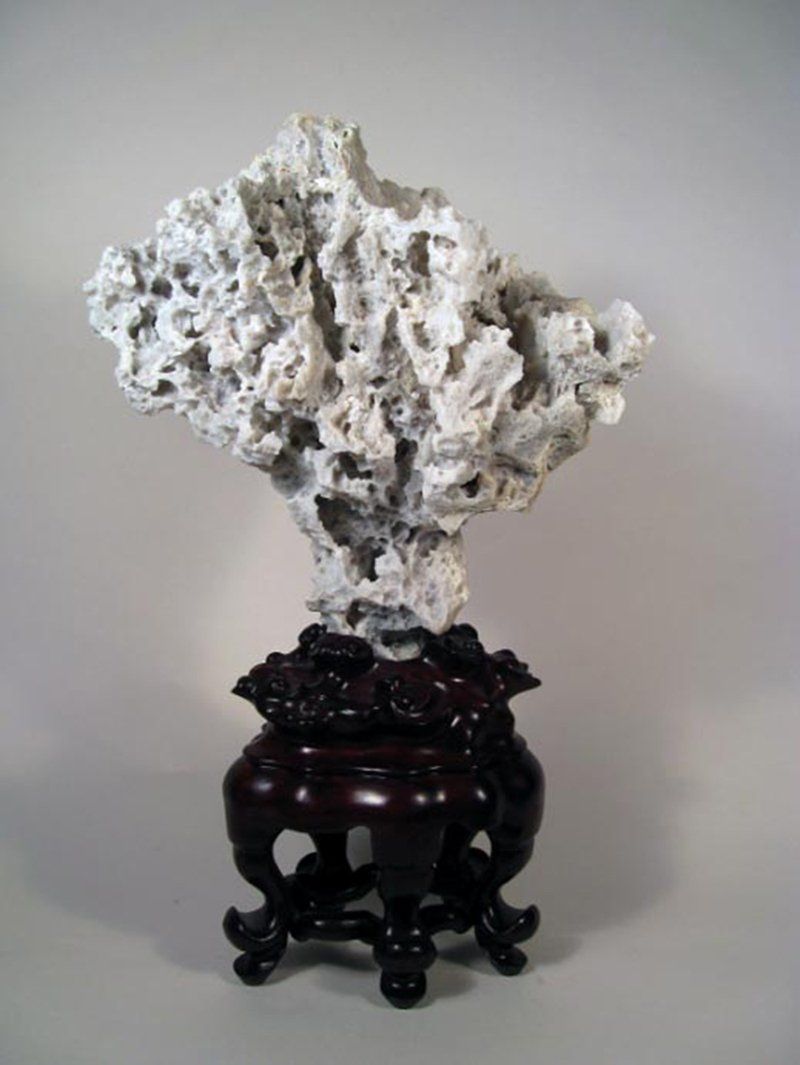Chinese Kun Stones or Kunshan StonesFamous Ancient Delicate White Stones
By Thomas S. Elias, February, 2013
Kun stones are beautiful, delicate, fragile white stones that are not commonly seen in markets today despite having been prized for nearly 1,000 years in China. The stones were mined from Ma-anshan (Ma-an Mountain), a small hill in Jiangsu Province. Jia (2010) stated that they are produced near Jade Peak in the Kun Mountains near Kunshan City, also in Jiangsu Province. Note that Kunshan is also known as Ma’anshan. The Kun stones consist of a complex assemblage of quartz druses that must be carefully cleaned to expose their delicate structure and white color. They are mostly small- to medium-sized stones ranging from only a few centimeters high up to ones 60 to 90 cm in length or height.
Kun stones are one of the oldest types to be collected and appreciated for their beauty and interest in China. It is the eighth stone listed in Du Wan’s Yulin Shipu, also referred to as Tu Wan’s Stone Catalogue of Cloudy Forest, which was published between AD 1126 and 1130. Kun stones are described in this book:
“A white stone, rugged and perforated, without sharp peaks. Recently a stone of identical was found in Hang-chou.”
Two Kun stones are illustrated and described in Lin Youlin’s book Suyuan Shipu or Suyuan Stone Catalogue published in AD 1613.
When the stones are extracted from the earth, they are covered with red mud that also fills the numerous cavities and holes. The stones are exposed to the sun to dry the mud, and then treated with boiling water, often with potash in the water to begin removing the mud. The stones must be soaked and rinsed in water for weeks, or in some cases months, to remove all of the material filling the cavities. If the exposed mineral formations still have a yellowish stain, they are treated with oxalic water (dilute oxalic acid) to remove any traces of this stain. There is considerable variation in mineral formations; often depending on the area of the mountain in which they were found. As a result, many types of Kun stones have been described. Here, we will present the five most commonly recognized types.
Snowflake Peak: Clear and transparent, these stones have the appearance of freshly fallen snow on twisted mountain ridges. The flakes may be small or large. This is a rare and is considered by specialists to be the most valuable of the Kun Stones.
Chicken Bone Peak: Clear and transparent with a smooth delicate texture, their thin mineral formations often twist and cross each other creating hundreds of holes and cavities. Sometimes, they are divided into thick chicken bone and thin chicken bone stones subcategories.
Jellyfish Peak: Hard and covered with jellyfish-like patterns, many of these stones create a feeling of grand landscapes. Their color may be white, light blue or yellow.
Walnut Peak: The surface shape resembles walnuts clustered together. They are clear and delicate and may appear as folded ribbons. Walnut peaked stones are often of lower quality.
Bay Berry Peak: The surface is covered with numerous, small irregular bumps that resemble crystallized bay berries. Stones of this type are rare.
Other types have been described; however, they are typically inferior in quality to those listed above. Their names, such as Bird Pee Peak, often reveal their standing and value in China. Excellent examples of the five principle types and others can be seen in the Kun Stone Pavilion in Tingling Garden in the City of Kunshan.
Kun stones were frequently the subject of many famous Chinese poets. Zhang Yu (Yuan dynasty) described them in his work Gaining Kunshan Stone as “The hidden circles are bones of the immortals, heavier than water there is a cold fragrance. The alone root standing in the snow supports the zither, small blossoms produce clouds and water the ink stone.” Lu You (Song dynasty) wrote in one of his poems “Acorus calamus from Yan Mountain and stones from Kun, one fist of (kun stone) is worth a thousand gold.” Many other writers and poets composed songs and poetry to praise these stones. Siren (1949) wrote that Kunshan stones were used to plant dwarf tree and irises and that they also were placed in bowls and used as miniature landscapes.
Kun stones can be purchased in certain markets, especially in Shanghai and in Jiangsu Province, for reasonable prices, with the exception of Snowflake Peak or a Chicken Bone Peak stones which command a premium price. Bases made for these stones are often elaborate to match the complex nature of the stones.
References: Hu, Kemin 2002, pp. 32-33; Jia Xiangyun 2010, Vol. 2: 430-431; Ren, David 2002, pp.218-221; Siren 1949, p. 25; Wu, Xinmin 2008.


